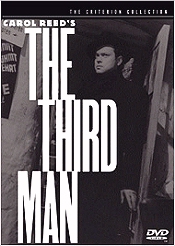 |
The Third ManRialto |
|---|
 |
The Third ManRialto |
|---|
|
Joseph Cotten - Holly Martins Alida Valli - Anna Schmidt Orson Welles - Harry Lime Trevor Howard - Major Calloway Paul Hoerbiger - The Porter Ernst Deutsch - Baron Kurtz |
Carol Reed - Director Carol Reed - Producer Robert Krasker - Cinematographer Graham Greene - Screenwriter Graham Greene - Original Story Anton Karas - Music |
In February 1948, producer Sir Alexander Korda sent novelist Graham Greene to Vienna to research a film about the post-war Four-Power (American, British, French, and Russian) occupation of the city. Two months later Greene delivered the story that served as a treatment for The Third Man. With Korda's persuasion, Hollywood producer David O. Selznick agreed to become a partner in the production. The arrangement called for Selznick to contribute a portion of the budget as well as some American stars. The film was to be directed and co-produced by Carol Reed, whose previous film, The Fallen Idol, had also been written by Greene.
True to his reputation, Selznick wrote countless memos to Korda and Reed during The Third Man's pre-production. The memos, outlining his suggestions for the film, were a considerable source of tension between Selznick and his British partners. One of the biggest points of contention between Reed and Selznick concerned the casting of Orson Welles. Reed thought he was perfect for the part of Harry Lime, while Selznick regarded him as box office poison. Although Reed had wanted James Stewart to play Holly Martins, he reluctantly accepted Selznick's top choice, Joseph Cotten. The casting of Italian actress Alida Valli was never an issue because from the outset, Selznick had conceived of The Third Man as a vehicle to showcase his contract star.
The shoot in Vienna commenced on October 22, 1948. The production was organized into three units manned by separate crews: day, night, and sewer. The production schedule provided very little time for sleep, but according to assistant director Guy hamilton, Reed directed all three units--virtually around the clock--with the help of Benzedrine. Because most of the film was shot at night or in the sewers, the day crew had the least work of the three units. The night unit produced many beautifully lit shots of Vienna's sumptuous architecture, capturing the character of the city. In fact, Reed had photographed a stunning Vienna-at-night sequence, which he ended up cutting. As much as the director loved the footage, he adhered to a strict discipline that every shot should serve a narrative purpose.
When Welles failed to arrive in Vienna when expected, Reed was forced to devise creative ways of shooting some of his character's scenes without him. Reed had assistant director Hamilton put on a black hat and a coat (with the hanger still in it to approximate Welles' stature), and instructed him to run in front of an arc light, creating the infamous Harry Lime shadow scenes. When Welles finally did arrive in Vienna, he was appalled by the conditions under which he was expected to work. After only one day of shooting in the sewers, Welles refused to return, necessitating the construction of a special sewer set at Shepperton Studios in England. Others who worked on the film recall that the Vienna sewer served as a perfect, climate-controlled studio.
Shooting ended in Vienna on December 11, 1948. Reed and his wife, Penelope Dudley Ward, attended a celebration where the director was presented with a commemorative plate by his crew. Filming began at England's Shepperton Studios in January 1948. Some of the Austrian actors were flown in from Vienna to shoot additional scenes. Famous Austrian actress Hedwig Bliebtreu portrays the landlady. Paul Hoerbiger, who played the Porter, learned his lines phonetically with the aid of Elizabeth Montague, who served as the Austrian advisor on the film. While the exterior of the Prater Wheel (Ferris Wheel) was shot on location, the ride's cabin interior was a set built at Shepperton.
When the film opened in London in September 1949, the music caused a sensation. The unknown zither player, Anton Karas, attracted as much attention as the stars. A recording of "The Harry Lime Theme" was hurriedly released and Karas embarked on a sold-out tour of Britain and America. When he returned to Vienna, he opened a bar and called it, appropriately, Der Dritte Mann (The Tird Man). Having garnered significant international box-office and critical success on its intitial release, The Third Man is still regarded as one of the greatest film noirs ever produced.
--from the Criterion Collection's special edition
DVD release of The Third Man, 1999.
A selection of Third Man related films.
|
Find Third Man on eBay.com
A selection of Third Man related books.
|
|
home: The Film Noir 'net |
back to: ALMOST NOIR |
|
Any comments, additions or suggestions
should be addressed to: The Film Noir 'net / Eric B. Olsen / ericbolsen@juno.com |
Other Web Sites:
History of Horror Hard Bop Homepage The War Film Web Author Eric B. Olsen |